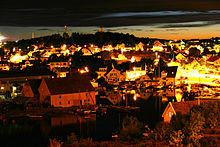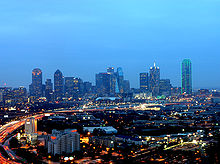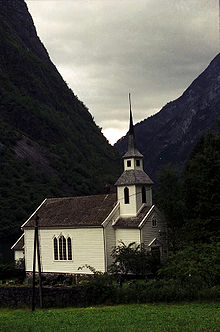- Demographics of Western Norway
-
 Some parts of western Norway have small populations, such as here at Stalheim, Voss.
Some parts of western Norway have small populations, such as here at Stalheim, Voss. See also: Demographics of Norway
See also: Demographics of NorwayWestern Norway shows the highest population growth rate in Norway in 2010, at 1,44%. The fertility rate in this region is higher than in other parts of Norway. The population as of 1 January 2010 is 1,263,464, with 37,7% of the population living in Hordaland, 33,8% in Rogaland, 19,8% in Møre og Romsdal, and 8,4% in Sogn og Fjordane. 60% of the population is under 40 years old, and 30% is under 20 years old. Many of the historical immigrants in Western Norway came from countries like Scotland, England, Netherlands, Germany, Denmark and Sweden. Western Norway is the part of Norway who has the larget immigration from the western world.
Contents
Statistics Norway demographic statistics
Historical populations Year Pop. ±% 1769 193,259 — 1801 230,053 +19.0% 1855 392,588 +70.7% 1900 560,765 +42.8% 1950 811,411 +44.7% 1955 846,977 +4.4% 1960 887,537 +4.8% 1965 919,909 +3.6% 1970 961,676 +4.5% 1975 1,002,465 +4.2% 1980 1,033,902 +3.1% 1985 1,061,367 +2.7% 1990 1,089,763 +2.7% 1995 1,124,756 +3.2% 2000 1,159,176 +3.1% 2001 1,164,937 +0.5% 2002 1,170,763 +0.5% 2003 1,178,263 +0.6% 2004 1,185,699 +0.6% 2005 1,193,168 +0.6% 2006 1,201,833 +0.7% 2007 1,212,856 +0.9% 2008 1,228,392 +1.3% 2009 1,245,439 +1.4% 2010 1,263,464 +1.4% 2015? 1,330,975 +5.3% 2020? 1,397,393 +5.0% 2025? 1,464,086 +4.8% 2030? 1,525,853 +4.2% Source: Statistics Norway [1][2][3][4][5][6][7][8][9]. The following demographic statistics are from the Statistics Norway, unless otherwise indicated.
Age and sex distribution
Age structure
Norway
(2010 est.)
0–14 years: 18.9% (male 470,253; female 447,472)
15–64 years: 66.2% (male 1,641,821; female 1,575,980)
65 years and over: 14.9% (male 314,678; female 407,995)Western Norway
(2010 est.)
0–14 years: 19.9% (male 128,405; female 123,094)
15–64 years: 65.8% (male 429,302; female 401,410)
65 years and over: 14.3% (male 79,008; female 102,245)Population
-
- 1,159,176 (January 1, 2000)
- 1,263,464 (January 1, 2010)
- Population growth
- 104,288 (8.9%)
-
- 1,263,464 (January 1, 2010)
- 1,397,393 (January 1, 2020)
- Population growth
- 133,929 (10.6%)
-
- 1,397,393 (January 1, 2020)
- 1,525,853 (January 1, 2030)
- Population growth
- 128,460 (9.1%)
Population - comparative
slightly larger than East Timor and Swaziland, but slightly smaller than Hawaii and Estonia.
Population growth rate
1.44% (in 2010)
Population growth rate - comparative
slightly larger than El Salvador and Iran, but slightly smaller than India.
Births and deaths
Births Deaths Birth surplus Birth rate Death rate Net migration rate 2000 16,345 10,405 5,940 14.1 8.9 -0.1 2008 16,644 10,028 6,616 13.5 8.1 8.5 Life expectancy at birth
(2008)
total population: 80.4 years
male: 77.8 years
female: 83.0 yearsTotal fertility rate
Western Norway have a higher fertility rate than Iran, Iceland, France and the United States, and it is the highest in Norway.
County Fertility rate (2009) Rogaland 2.18 Møre og Romsdal 2.13 Sogn og Fjordane 2.10 Hordaland 2.03 Language
Main article: Norwegian languageLiteracy
definition: age 15 and over can read and write
total population: 100%
male: NA%
female: NA%Immigration
Country of origin  Norway
NorwayImmigrants Eastern Europe Asia Western Europe Africa Nordic countries Latin America North America Oceania Total Population [1] 1,148,324 115,140 35,913 33,154 16,726 11,085 10,103 5,082 2,588 489 1,263,464 Percent of total 90.88% 9.11% 2.84% 2.62% 1.32% 0.87% 0.79% 0.40% 0.20% 0.03% 100% Percent of immigrants 100% 31.19% 28.79% 14.52% 9.62% 8.77% 4.41% 2.24% 0.42% 9.11% Country of origin  Norway
NorwayImmigrants Asia Eastern Europe Western Europe Africa Nordic countries Latin America North America Oceania Total Hordaland [1] 434,081 42,374 12,292 13,065 5,325 4,740 3,405 2,497 872 178 477,175 Rogaland [1] 378,956 48,991 14,989 14,334 7,465 4,391 4,447 1,758 1,370 237 427,947 Møre og Romsdal [1] 234,477 16,785 6,143 4,338 2,680 1,287 1,541 496 243 57 251,262 Sogn og Fjordane [1] 100,090 6,990 2,489 1,417 1,256 667 710 331 103 17 107,080 Immigrants in Bergen and Stavanger
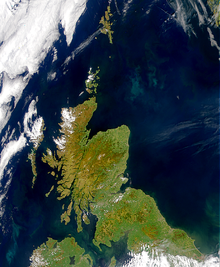 Many people had emigrated from the neighbour to the west, Scotland.
Many people had emigrated from the neighbour to the west, Scotland.
Country Inhabitants[2] Total 380,450 Ethnic Norwegians 331,209 Immigrants 49,241  Poland
Poland5,085  United Kingdom
United Kingdom2,336  Iraq
Iraq2,067  Germany
Germany1,890  Vietnam
Vietnam1,827  Sweden
Sweden1,780  Turkey
Turkey1,769  Somalia
Somalia1,746  Denmark
Denmark1,382  Bosnia and Herzegovina
Bosnia and Herzegovina1,327 Religion
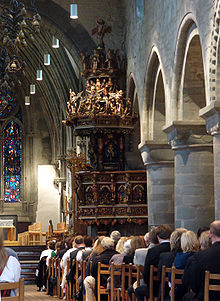 A liturgy in Stavanger Cathedral.
A liturgy in Stavanger Cathedral. Saint Paul Church, a catholic church in Western Norway.
Saint Paul Church, a catholic church in Western Norway.
Christianity is the largest religion. 1,054,573 people are members of the Church of Norway. There is also 52,365 members in other Christian churches. Islam have 10,685 members in Western Norway. Buddhism have 2,082 members. 1,171 are from Bahá'í Faith, Judaism, Sikhism and other related religions.
There are more than thousand protestant churches (in all municipalites), six catholic churches (in Bergen, Stavanger, Haugesund, Ålesund, Molde and Kristiansund), two mosques (in Bergen and Stavanger), two orthodox churches (in Bergen and Stavanger), and one hindu temple (in Bergen).
The name "Bible Belt" has been applied historically to the Southern and Western parts of Norway. The region thus defined included most of Western Norway, especially Rogaland, Møre og Romsdal and some parts of Hordaland. Notably absent from this belt are bigger cities like Bergen and Stavanger where many people identify themselves as non-religious or with other religions. In these areas the conservative branch of the Church of Norway has a stronghold and the members usually associate themselves to Indremisjonen (Inner Mission). There are also numerous Pentecostals and members of the Free Churches, but these movements are also strongly represented in the rest of the country. The Bible Belt in Norway traditionally reflects the support for the Christian Democratic Party. However, especially since the first decade of the 21st century, conservative bible belt Christians unhappy with the more liberal development of the party have increasingly turned to the Progress Party.[3][4]
Christianity
Christianity is the largest religious group. Although more and more ethnic Norwegians are less religious, increasing the number of Christians because it is so large immigration of Christians. Many known Christian missionars came from Western Norway, for example Torill Selsvold Nyborg who is now county mayor of Hordaland.
Year 2006 2007 2008 2009  Christianity in Western Norway
Christianity in Western Norway1,099,277 1,103,804 1,105,047 1,104,127 Percent 91.4% 91.0% 89.9% 88.6% Protestantism
Year 2005 2006 2007 2008 2009  Members in Church of Norway
Members in Church of Norway1,062,634 1,051,209 1,053,114 1,054,573 1,051,762 Percent of total population 89.0% 87.4% 86.8% 85.8% 84.4% 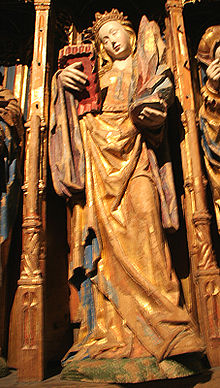 Statue of Saint Sunniva, the patron saint of the Norwegian Diocese of Bjørgvin. According to legend, Sunniva was the heir of an Irish kingdom, but had to flee when a heathen king, who wanted to marry her, invaded. At the Norwegian island of Selja, in the present-day municipality of Selje, she and her followers took refuge in a cave. The locals suspected the foreigners of stealing their sheep, and the ruler Håkon Jarl was sent for. Sunniva and her followers prayed to God that they should not fall into the hands of the heathens, upon which rocks fell down blocking the entrance to the cave.
Statue of Saint Sunniva, the patron saint of the Norwegian Diocese of Bjørgvin. According to legend, Sunniva was the heir of an Irish kingdom, but had to flee when a heathen king, who wanted to marry her, invaded. At the Norwegian island of Selja, in the present-day municipality of Selje, she and her followers took refuge in a cave. The locals suspected the foreigners of stealing their sheep, and the ruler Håkon Jarl was sent for. Sunniva and her followers prayed to God that they should not fall into the hands of the heathens, upon which rocks fell down blocking the entrance to the cave.
Protestantism is the majority religion in Norway. Most of them is Lutheran and members in the Church of Norway. Over 85% of the population is member here. Every municipalities have a protestant churches. Many municipalites, for example Austevoll, a small municipality with around 4,000 inhabitants, have over 13 church buildings. Most Norwegians are not active in the church. Nevertheless, there are many who participate to worship at Christmas Eve. People outside the cities are often more religious than the population in the cities, although there are many religious Christians immigrants in the cities.
Catholicism
Catholicism increased their members because a lot of immigrants from Poland, Philippines, Chile and other Latin Americans and European countries. There are six catholic churches (as of 2004), in Bergen (4,925 members), Stavanger (2,863 members), Haugesund (822 members), Ålesund (595 members), Molde (289), Kristiansund (212). The largest church is St. Paul church in Bergen. The number of Catholics increased rapidly from 2005, because of immigration (mainly Polish). The capacity here is too small for all Catholics. It is therefore planned to build several Catholic churches in the region, in addition to Orthodox churches.[5]
Year 1995 2000 2004 Members in the Catholic Church 7,760 8,721 9,706 Percent 0.68% 0.75% 0.81% Orthodoxy
There are only two Orthodox congregations in Western Norway, in Bergen and Stavanger. 368 people are member in Stavanger, but not all of them live in Rogaland. congregations in some churches in Bergen have Orthodox worship in different languages. In the Catholic Church in Bergen, the liturgy is also in different languages. The numbers of orthodox increased because immigration from countries like Russia and other east European countries.[5]
Pentecostalism
9,803 people are Pentecostalists.[5]
Jehovah's Witnesses
3,876 people are Jehovah's Witnesses,[5] up from 3,872 in 2003.
Methodism
3,692 people are Methodists.[5]
Baptism
1,949 people are Baptists,[5] up from 1,880 in 2003.
The Norwegian Mission Association
1,314 people are members in the Norwegian Mission Association.[5]
Adventism
1,086 people are members in the Seventh-day Adventist Church.[5]
Islam
While as many as 7.2% of Oslo's population are Muslims, this figure is only 0.85% in Western Norway. There are two mosques, one in Bergen and Stavanger. In total, 10,685 people members of this religious community.[6]
Year 2006 2007 2008 2009  Islam in Western Norway
Islam in Western Norway8,697 9,540 9,578 10,685 Percent 0.72% 0.78% 0.77% 0.85% Buddhism
Buddhism increased their number of adhertens from 0 in 2004 to 2,082 in 2009.
Year 2006 2007 2008 2009 Buddhism in Western Norway
1,489 1,583 1,689 2,082 Percent 0.12% 0.13% 0.13% 0.16% Others
Year 2006 2007 2008 2009 Bahá'í Faith, judaism, sikhism in Western Norway 1,140 1,181 1,171 1,397 Percent 0.09% 0.09% 0.09% 0.11% Judaism
See also: History of the Jews in NorwayWestern Norway have a small jewish coummunity. It has never been a synagogue in this part of the country, but before World War II, it was one congreation in Bergen and one in Kristiansund.
References
- ^ a b c d e Immigrants and Norwegian-born to immigrant parents by country background and county. 1 January 2010
- ^ "Immigrants and Norwegian-born to immigrant parents by country of birth1,(the 20 largest groups).Selected municipalities.1 January 2009". Statistics Norway. http://www.ssb.no/english/subjects/02/01/10/innvbef_en/tab-2009-04-30-11-en.html. Retrieved 2009-07-06.[dead link]
- ^ Aalberg, Per Ole (16 September 2003). "KrF kraftig tilbake i bibelbeltet". DagenMagazinet. http://www.dagenmagazinet.no/Nyheter/Samfunn/tabid/248/articleView/true/ModuleId/42418/Default.aspx.
- ^ Horn, Anders (23 August 2008). "Stjeler fra Høyre". Klassekamoen. http://www.klassekampen.no/artikler/kommentarer/54978/article/item/null.
- ^ a b c d e f g h From 2004
- ^ From 2009
 Categories:
Categories: -
Wikimedia Foundation. 2010.


